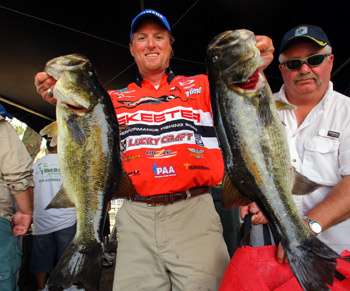
If there's a common thread that runs through all bass anglers, it's that we want to catch big fish and lots of them. Everyone from Elite pros to weekend Joes hope to get a trophy fish on every cast. That's part of what makes fishing exciting. Since lunkers are most always the goal, you need to know where they are and what they want.
Find 'em first
A critical part of catching big fish is finding their haunts and then knowing how to fish them effectively. When trophy hunting, Elite Series pro and big bass specialist Kelly Jordon looks for irregularities in the bottom structure. Close proximity to deep water is also important. More specifically, he targets humps, ledges, points and other traditional structure. While lunkers can and do go shallow, Jordon has found that most really big bass are deeper.
"Finding the depth the fish are at is the best place to start. From there, move and find structure in that range," he said. "Once you find where the fish are, then it's time to throw stuff for the big ones."
Big fish eat big
Jordon's favorite big fish baits are mostly swimbaits, particularly the 5-inch Storm WildEye Swim Shad. His preferred casting outfit is a one piece, 7-foot, 9-inch Fenwick Techna AV Flippin' Stik with an Abu Garcia Revo reel spooled with 25-pound-test Berkley Trilene 100% Fluorocarbon line. After making a long cast, Jordon works the bait in one of three ways. His favorite retrieve is the "burn and kill" method. Once the bait is at the optimum depth, he turns the reel as fast as possible five to seven times while keeping the rod motionless.
"Keep the rod at just above nine o'clock, but don't move it," the Texas pro said. "If you move it, it could potentially take the bait out of a fish's mouth. After you burn it for a few rotations, stop it, and let the bait fall. Ninety five percent of all hits come on the fall."
If that doesn't get any fish, Jordon will bounce the bait off the bottom like a worm, rustling up dirt and debris. He says that if the bass have bait pinned down, the big ones will come and pick up the wounded fish below.
His third favorite presentation is a slow roll in which he reels slowly then pauses, once again letting the bait fall before he picks it up again. Jordon will often rotate between these three retrieves until he zeroes in on what the bass want that day or in a particular location.
Big bass love the nightlife
According to Jordon, if you only fish during daylight, you may be cutting your chances of catching the fish of a lifetime in half.
"John Hope did some studies here in Texas where he tagged some fish and found that there is a good portion of bass that eat mainly at night," he said. "Think of an African plain. The big boys come out at night, so the small critters go find somewhere to hide."
For his night fishing, Jordon stashes the swimbaits since he believes the bass need to see them from some distances in order for them to be most effective. In their stead, he opts for big black spinnerbaits with Colorado blades, rattling jigs or 10-inch worms. The more commotion a bait creates the better as far as Jordon is concerned. He also says that when you do feel a monster bass hit, set the hook as hard as possible since bigger bass are harder to hook properly. Using large, sharp hooks help your chances.
You want things that make a lot of noise and vibration so the fish have something to target," he said. "In clear water, you can get away with a few dark natural colors, but in stained water stick to black and black and chartreuse combos. These have the best profile."
Fishing at night also keeps you out of the searing sun and heat, which can ruin a fishing trip if you don't take necessary precautions, like wearing sun block and long sleeve shirts. Lakes are typically less active at night, too, so you'll be competing with fewer anglers.
Taking on the biggest fish in the lake can be daunting, but even the biggest bass can be tamed if you can find them and give them what they want. Take a clue from Kelly Jordon to turn the dog days into hawg days.




